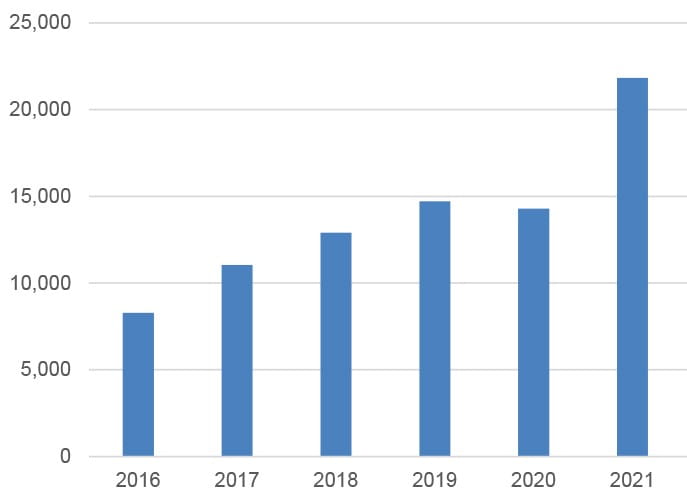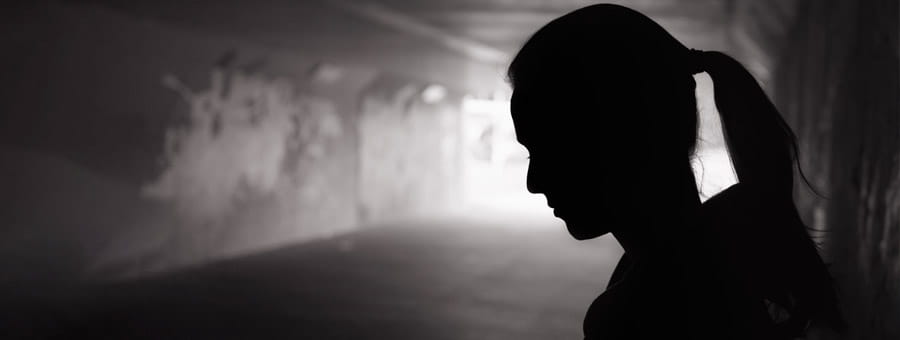Increasing cases of pediatric suicidality highlight the ongoing mental health crisis among youth. Suicide attempts, ideation, and self-injury have become the most common mental health conditions seen in children’s hospitals’ emergency departments, according to data from the Children’s Hospital Association’s Pediatric Health Information System (PHIS®).
Between 2016 and 2021, suicide self-injury cases among patients ages 5-18 seen at children's hospital emergency departments increased by 168.6%. The trend in cases has remained essentially unchanged for the past four years, meaning the crisis is not abating.
“Not only have the numbers increased, but we are also seeing worse acuity — children don’t get to us until their illness is more advanced, such as having persistent suicidal ideation instead of initially fleeting thoughts,” says Heather Huszti, chief of psychology at Children’s Hospital of Orange County (CHOC).
Around one-fifth of all adolescent deaths are from suicide. It is the second leading cause of death among young people 10-14 years old and third leading cause of death for those between 15-24. In 2024, suicide self-injury made up more than a third of visits to children’s hospitals' emergency rooms.
“As tempting as it might be to pin this increase on one specific thing, it is likely to be a complex interaction of several factors. Children’s hospitals must continue to invest in and advocate for children’s mental health,” Huszti said.

Who’s affected?
While rare in children younger than 10 years, suicide death rates increase markedly during adolescence and young adulthood. According to the CDC's Youth Risk Behavior Survey Data Summary and Trends Report, among high school students in 2021:
- 20% seriously considered attempting suicide.
- 16% made a suicide plan.
- 9.5% attempted suicide.
Mental health issues and suicidality affect children across the board, but subsets of students have very different experiences, with some faring worse, according to the CDC report.
Gender
In 2023,13% of female students attempted suicide. Almost 30% of girls said they seriously considered attempting suicide, nearly double the rate among boys. More than half of female students experienced persistent feelings of sadness or hopelessness.
Race and ethnicity
Suicide is now the leading cause of death for Asian American youth. A quarter of American Indians and Alaska natives said they had seriously considered a suicide attempt.
Sexual identity
Almost 20% of LGBTQ+ students attempted suicide during the past year. Close to 70% experienced persistent feelings of sadness or hopelessness.
Responding to the crisis
Health care organizations and children’s hospitals are innovating care, adding services, and reimaging the future of behavioral health care to meet immediate needs.
In 2021, Children’s Hospital Association (CHA), American Academy of Pediatrics (AAP), and the American Academy of Child and Adolescent Psychiatry declared a national state of emergency in children’s mental health. The declaration called on policymakers at all levels of government and advocates for children and adolescents to increase funding, address regulatory challenges, address acute care needs, and more.
CHA also joined with Cardinal Health Foundation and the Zero Suicide Institute to create Preventing Youth Suicide: A Cardinal Health Foundation National Collaborative. The first-of-its-kind collaborative develops a data-driven approach to accelerate improvement in the identification and care of children at risk for suicide.
Since 2022, the 39 hospitals that make up the collaborative have implemented many changes in suicide care, including screening, data collection, training staff, and building a culture that recognizes the importance of this work.
“This initiative has transformed how we care for children’s mental health—across every setting. It gave us a shared framework and empowered our teams to screen universally for suicide risk, intervene early, and respond with compassion,” said Dr. Linda Mayes, chief of child psychiatry at Yale New Haven Health System and chair of the Yale Child Study Center. “Most importantly, we’ve built a system where every child is seen, every concern is heard, and every risk is met with care and connection.”
In addition, CHA partnered with other organizations to launch the advocacy initiative Speak Our Minds, which urges Congress to enact legislation and increase funding to address the crisis.
Resources and strategies
Along with creating partnerships, children’s hospitals and health systems are developing resources, tools, and strategies for combatting youth suicide.
- Advocacy-related work to improve the entire system, including a documentary and reference materials.
- Collection of solutions from children's hospitals covering early intervention, workforce, community partnerships, and emergency care.
- Virtual learning series designed to drive action and implementation.
- A tangible way to prevent youth suicide.
- Restricting lethal means report.
- Blueprint for Youth Suicide Prevention from AAP and American Foundation for Suicide Prevention.
- Youth Suicide Prevention and Intervention Best Practices and Policy Implications from Nationwide Children’s and Springer.
- Guide for Schools on Student-Directed Suicide Prevention Program from Cincinnati Children’s.
- Care of the pediatric patient with suicidal ideation course from CHA’s Pediatric Learning Solutions (PLS).
- Pediatric behavioral and mental health course library from PLS.
- Peer-to-peer online community intended to facilitate communication about programs, staff support, cost of care, and other behavioral health topics.
6,400
10- to 24-year-olds die by suicide each year
1/3
of all ED visits at children's hospitals are for suicide/self-injury
20%
of high schoolers say they think seriously about suicide






